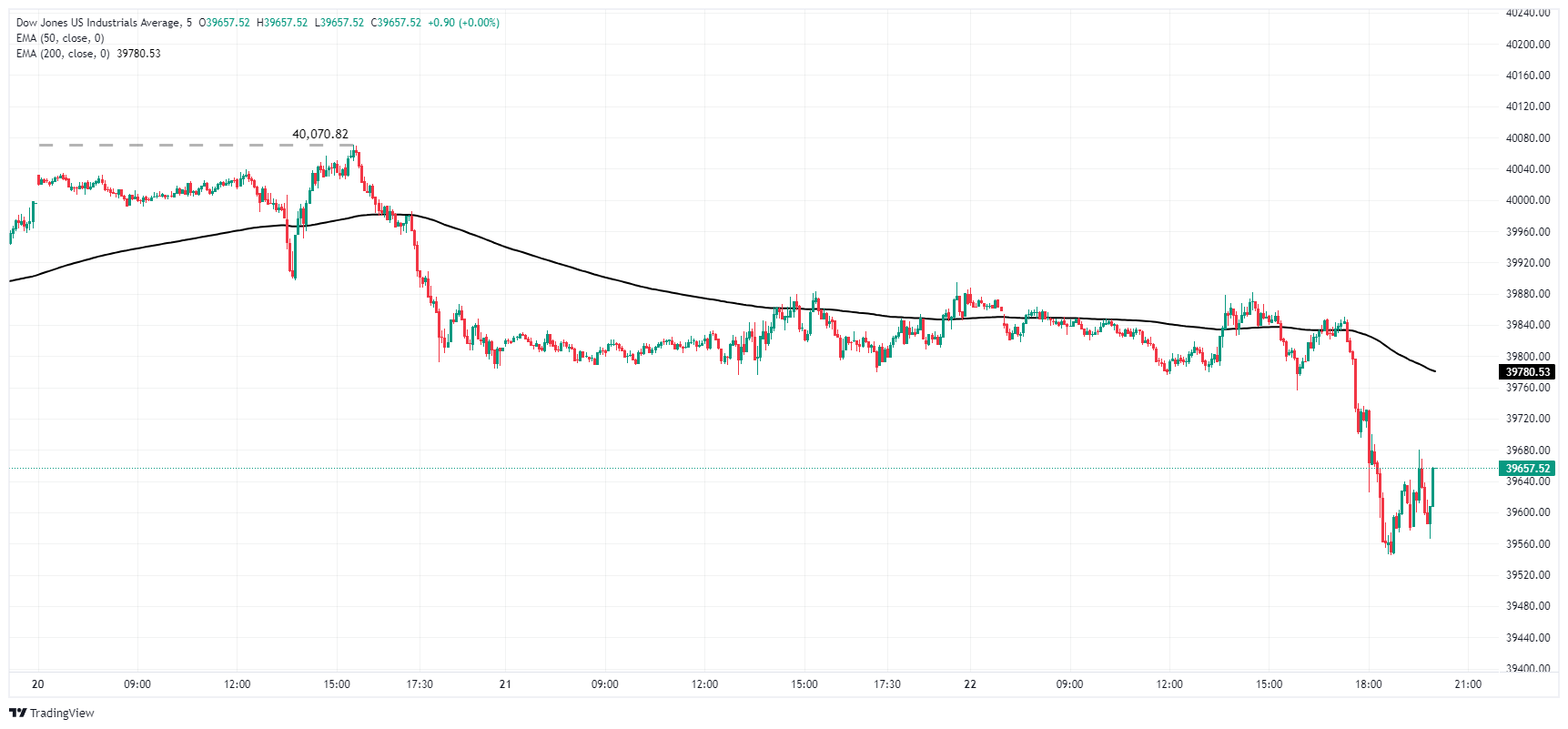- Dow Jones slips lower on Wednesday after FOMC Meeting Minutes.
- Hopes for a September rate cut are beginning to dry up.
- US PMI, Durable Goods Orders in the pipe for later in the week.
The Dow Jones Industrial Average (DJIA) slipped back during US market session on Wednesday as investors continue to get pushed back on broad rate cut expectations. A recent decline in US Consumer Price Index (CPI) inflation helped to bolster traders’ confidence in a September rate trim from the Federal Reserve (Fed). However, still-high inflation numbers well above the Fed’s 2% target range and a cautionary warning from Fitch Ratings that global services inflation is likely to remain higher for longer are battering investors’ rate cut dreams.
Read more: Fed Minutes leave the door open to a probable rate cut in September
Fitch Ratings announced on Wednesday that global services inflation will likely remain higher for longer than originally anticipated, meaning interest rates are unlikely to recede nearly as quickly as investors have hoped through all of 2024. According to the CME’s FedWatch Tool, rate markets are pricing in only 60% odds of a quarter-point rate cut from the Federal Open Market Committee (FOMC) in September, tumbling from 70% in a matter of days. In December, rate traders were pricing in better-than-even odds of six rate cuts in 2024 from the FOMC beginning in March. Fast forward to today, and investors are seeing the door slowly close on two rate cuts for the year beginning in September.
The FOMC’s latest Meeting Minutes published on Wednesday, and while the FOMC didn't completely rule out September rate cut, odds are looking slimmer as Fed policymakers reiterated the need to wait for stronger evidence that inflation would continue easing to the US central bank's 2% target.
Dow Jones news
The Dow Jones traded mostly flat on Wednesday in the run-up to FOMC Meetings Minutes. Post-FOMC release, the Dow Jones shed around one half of one percent, backsliding around 200 points as investors balk at a Fed less willing to engage in rate cuts as investors continue to hope for.
Dow Inc. (DOW) fell -2.22% on Wednesday, trading below $57.60 and extending a backslide from a 52-week high set only a week ago. On the high side, Johnson & Johnson (JNJ) climbed 1.49% to $153.50 per share after reporting Q1 net profit of $3.26 billion. JNJ had posted a net loss of $68 million the previous quarter.
Dow Jones technical outlook
The Dow Jones has backslid from a recent all-time record high of 40,070.82, but intraday action has found a technical floor at 39,775.00. The equity index has been unable to recapture 39,900.00, but the DJIA remains firmly bullish in the medium-term.
The Dow Jones is trading well above the 200-day Exponential Moving Average (EMA) at 37,142.67 as investors take a breather from a broad-market bull run, but profit-taking remains thin keeping the DJIA bolstered firmly into bull country.
Dow Jones five minute chart
Dow Jones daily chart
Dow Jones FAQs
The Dow Jones Industrial Average, one of the oldest stock market indices in the world, is compiled of the 30 most traded stocks in the US. The index is price-weighted rather than weighted by capitalization. It is calculated by summing the prices of the constituent stocks and dividing them by a factor, currently 0.152. The index was founded by Charles Dow, who also founded the Wall Street Journal. In later years it has been criticized for not being broadly representative enough because it only tracks 30 conglomerates, unlike broader indices such as the S&P 500.
Many different factors drive the Dow Jones Industrial Average (DJIA). The aggregate performance of the component companies revealed in quarterly company earnings reports is the main one. US and global macroeconomic data also contributes as it impacts on investor sentiment. The level of interest rates, set by the Federal Reserve (Fed), also influences the DJIA as it affects the cost of credit, on which many corporations are heavily reliant. Therefore, inflation can be a major driver as well as other metrics which impact the Fed decisions.
Dow Theory is a method for identifying the primary trend of the stock market developed by Charles Dow. A key step is to compare the direction of the Dow Jones Industrial Average (DJIA) and the Dow Jones Transportation Average (DJTA) and only follow trends where both are moving in the same direction. Volume is a confirmatory criteria. The theory uses elements of peak and trough analysis. Dow’s theory posits three trend phases: accumulation, when smart money starts buying or selling; public participation, when the wider public joins in; and distribution, when the smart money exits.
There are a number of ways to trade the DJIA. One is to use ETFs which allow investors to trade the DJIA as a single security, rather than having to buy shares in all 30 constituent companies. A leading example is the SPDR Dow Jones Industrial Average ETF (DIA). DJIA futures contracts enable traders to speculate on the future value of the index and Options provide the right, but not the obligation, to buy or sell the index at a predetermined price in the future. Mutual funds enable investors to buy a share of a diversified portfolio of DJIA stocks thus providing exposure to the overall index.
Information on these pages contains forward-looking statements that involve risks and uncertainties. Markets and instruments profiled on this page are for informational purposes only and should not in any way come across as a recommendation to buy or sell in these assets. You should do your own thorough research before making any investment decisions. FXStreet does not in any way guarantee that this information is free from mistakes, errors, or material misstatements. It also does not guarantee that this information is of a timely nature. Investing in Open Markets involves a great deal of risk, including the loss of all or a portion of your investment, as well as emotional distress. All risks, losses and costs associated with investing, including total loss of principal, are your responsibility. The views and opinions expressed in this article are those of the authors and do not necessarily reflect the official policy or position of FXStreet nor its advertisers. The author will not be held responsible for information that is found at the end of links posted on this page.
If not otherwise explicitly mentioned in the body of the article, at the time of writing, the author has no position in any stock mentioned in this article and no business relationship with any company mentioned. The author has not received compensation for writing this article, other than from FXStreet.
FXStreet and the author do not provide personalized recommendations. The author makes no representations as to the accuracy, completeness, or suitability of this information. FXStreet and the author will not be liable for any errors, omissions or any losses, injuries or damages arising from this information and its display or use. Errors and omissions excepted.
The author and FXStreet are not registered investment advisors and nothing in this article is intended to be investment advice.
Recommended content
Editors’ Picks

Gold falls amid a possible de-escalation of US-China tensions Premium
Gold pulled back from its all-time high of $3,500 per troy ounce reached earlier on Tuesday, as a resurgent US Dollar and signs of easing tensions in the US–China trade dispute appeared to draw sellers back into the market.

EUR/USD tumbles to near 1.1350 on renewed US Dollar demand
The EUR/USD pair attracts some sellers to around 1.1355 during the early Asian session on Wednesday, pressured by the renewed US Dollar demand. The Greenback recovers after US President Donald Trump said he had no intention of firing Federal Reserve Chair Jerome Powell despite his frustration with the central bank not moving more quickly to slash interest rates.

GBP/USD deflates to weekly lows near 1.3350
GBP/USD loses further momentum and recedes to the 1.3350 zone on Tuesday, or two-day troughs, all in response to the frmer tone in the US Dollar and encouraging news from the US-China trade scenario.

Ethereum rallies 10% amid decline in CME short positions
Ethereum saw a 10% gain on Tuesday after the general crypto market rallied alongside Bitcoin. The rally comes after the ETH Chicago Mercantile Exchange basis plunged from 20% in November to about 5% in April.

Five fundamentals for the week: Traders confront the trade war, important surveys, key Fed speech Premium
Will the US strike a trade deal with Japan? That would be positive progress. However, recent developments are not that positive, and there's only one certainty: headlines will dominate markets. Fresh US economic data is also of interest.

The Best brokers to trade EUR/USD
SPONSORED Discover the top brokers for trading EUR/USD in 2025. Our list features brokers with competitive spreads, fast execution, and powerful platforms. Whether you're a beginner or an expert, find the right partner to navigate the dynamic Forex market.



